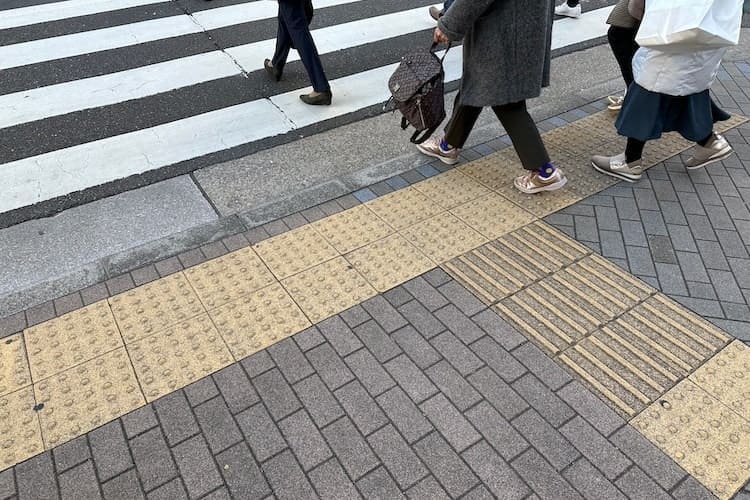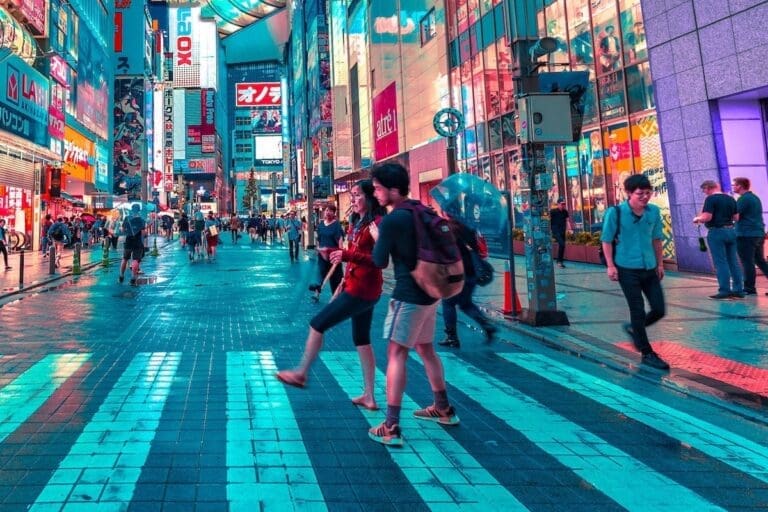Traveling to Japan blind or with a visual impairment might sound intimidating, but don’t let that hold you back. Japan is a country that has taken significant strides in making its cities, transportation, and public spaces accessible to all, including blind or visually impaired travelers. Let’s explore the accessibility features that make Japan a welcoming destination for visually impaired tourists.
- Transportation: Is Japan’s transportation system easy to navigate for a blind person?
- Special Services and Facilities for Blind or the Visually Impaired
- Accommodation: What Accommodations are Blind-friendly in Japan?
- Sightseeing & Attractions: Which tourist spots are most accessible or provide tactile experiences?
- Cultural Considerations: How to communicate your needs to locals and understand local customs?
- Key Takeaways for Visually Impaired Travelers Heading to Japan
Transportation: Is Japan’s transportation system easy to navigate for a blind person?
Navigating Airports
Airports in Japan, especially the major ones like Narita and Haneda, are designed keeping accessibility in mind.
The staff are often trained to assist travelers with disabilities, and there are tactile pathways and audio announcements to guide you.
Train Stations and Subways in Japan
However, it’s the trains and subways where Japan truly shines. And that’s good, because you will take a lot of while traveling in Japan and especially Tokyo.
Japan’s train stations are equipped with fully tactile maps that include braille, allowing visually impaired travelers to navigate complex transit systems with ease.
Additionally, stations offer auditory guidance and frequent audio announcements in both Japanese and English, providing clear directions and descriptions of the surroundings.
Every station has tactile paving on platforms that visually impaired travelers can feel with their cane and their feet.
Note that most busy metro stations also have gates in front of the tracks that open only when the metro has arrived and is stopped. It helps prevent people from jumping onto the tracks (suicide by jumping in front of a train is real in Japan, and it even has its own name: 飛び込み自殺 – tobikomijisatsu), drunk people from accidentally falling onto the track, as well as serves as a protection for blind people.
Beyond the standard features, Japan’s transportation hubs often offer special services tailored for those with visual impairments.
You might come across ‘Travel Support’ counters at major train stations, where they assist boarding trains. In many cases, a staff member might guide you from one platform to another or even help you find your seat.
But if not, remember to ask for help if needed, because folks are generally more than willing to assist.
Buses
Buses, on the other hand, can be a tad trickier. But here’s the silver lining: many bus stops, particularly in cities like Tokyo and Kyoto, announce the upcoming stops audibly.
And if you ever find yourself unsure, just ask a fellow passenger or the bus driver.
Special Services and Facilities for Blind or the Visually Impaired
Tactile Paving: Braille Blocks Underfoot
One of the most notable accessibility features in Japan is the widespread use of braille blocks, also known as “Tenji Blocks” or tactile paving.
These features are not just limited to crosswalks but extend to sidewalks, train stations, and other public areas, guiding visually impaired individuals safely through various paths.
Invented in Japan in the 1960s and mandated nationwide by 1985, these tactile paths are a testament to Japan’s commitment to accessibility.

Pedestrian-Friendly Areas
Certain districts, such as Ginza in Tokyo, enhance the pedestrian experience by closing off streets to vehicle traffic on weekends.
This creates a safer and more enjoyable environment for visually impaired visitors, who can explore without the fear of cars and enjoy the spacious streets and sidewalks.
Elevators and Toilets: Clean and Accessible
Many elevators In Japan are designed with features such as accessible buttons, braille, and auditory feedback.
And for those moments when you’re looking for a restroom, many come with braille instructions for every control.
The cleanliness of public spaces especially the toilet is something many tourists notice. They’re cleaned many times a day, and if something happens, a cleaning staff is sent right away to take care of the mess.
It’s clear: Tokyo wants to ensure that everyone, regardless of their ability, can explore the city with ease and confidence.
Accommodation: What Accommodations are Blind-friendly in Japan?
Hotels and Accommodations with Specialized Facilities or Services
Finding the right place to rest after a long day is crucial.
Many hotels in Japan and especially in Tokyo feature braille room directories and incorporate tactile guides that lead directly to entrances and elevators, which are equipped with braille and auditory announcements in both Japanese and English.
And here again, the staff is also always helpful. Japan is renowned for its hospitality, and hotels are no exception.
Traditional Japanese Accommodations and Their Accessibility for Blind People
Now, if you’re thinking of diving into the more traditional side of Japan, you should go for ryokans. These are traditional Japanese inns, offering a unique taste of Japanese culture.
From the texture of tatami mats to the rustling of sliding shoji doors, they’re a treat for the senses.
It’s worth noting, though, that while many ryokans are striving to be more accessible, they vary in their offerings. Always best to communicate your needs when booking to ensure a comfortable and memorable stay.
Sightseeing & Attractions: Which tourist spots are most accessible or provide tactile experiences?
For those keen on truly feeling the pulse of the city, Tokyo doesn’t disappoint.
You can start with the digital museum teamLab Borderless in Tokyo, a huge museum in Roppongi priding itself in offering an immersive experience.
But especially, make sure not to miss teamLab Planets (same brand, but different museum) where art isn’t just seen, but felt and heard. To give you a taste: the first experience of this museum is to go up a small waterfall in the dark, barefoot.
Then there are sensory gardens throughout the city, providing a soothing experience as you feel the unique textures underfoot and let the tranquil music wash over you.
Several museums, recognizing the importance of inclusive experiences, also offer touch exhibits.
And as for things to do, don’t forget onsen. They’re one of my favorite things about Japan. You don’t need sight in there. Just submerge yourself in hot water, and relax.
Cultural Considerations: How to communicate your needs to locals and understand local customs?
I stressed it out too many times in this article already, but the Japanese are known for their politeness and are always willing to help.
If they see you struggling, chances are someone will stop and ask if you need help.
If not, don’t hesitate to ask for help when needed.
How to communicate with Japanese people? Tips on Language and Gestures
Many Japanese people in Tokyo can understand basic English. Speak slowly, and use simple words. You don’t need to make grammatically correct sentences – sometimes stressing out one or two words will be better understood than forming a full sentence.
If the person doesn’t speak a word of English, while knowing some basic Japanese phrases can be super helpful, technology’s got your back if you’re lost in translation. Tools like translation apps as simple as Google Translate can bridge the language gap.
As for gestures, a light simple bow goes a long way in showing respect. Don’t shy away from using universally understood gestures either; a smile or a nod will work well too.
And in general when trying to communicate with Japanese people, a calm approach and patience can make all the difference.
Key Takeaways for Visually Impaired Travelers Heading to Japan
Before you start packing your bags, let’s zoom in on some final tips and key takeaways to make your Japan journey not just doable, but genuinely enjoyable.
1. Do some homework: Research accessible options for accommodation, travel, and sights. Plenty of resources are out there, both online and offline. Being prepared is half the battle.
2. Technology is your friend: Utilize the available apps and tech tools specifically designed for visually impaired travelers. They can help you navigate the city, translate languages, and even read out signs for you.
3. Mind the blocks: Japan’s tactile ground surface indicators, known locally as ‘tenji blocks,’ are your guide through subway stations and even some streets. They are super helpful in providing a sense of direction.
4. Local help is golden: Japanese people are incredibly respectful and willing to help, so don’t hesitate to ask for assistance. Organizations specializing in aiding visually impaired travelers can provide valuable advice and services, so reach out to them in advance.
5. Experience over sight: Opt for experiences that aren’t just about the visual aspect but engage other senses as well. Whether it’s the textures of a sensory garden, the sounds of a traditional tea ceremony, or the tastes of authentic sushi, make the most of what Japan has to offer.
6. Be respectful: While Japan is wonderfully accommodating, it’s always a good idea to understand basic local customs. A simple bow, a thank you in Japanese (‘Arigatou’), or even just showing interest in the culture can go a long way.
7. Savor the details: Japanese culture thrives in its details, be it in their art, food, or architecture. While you might not see it, you can definitely feel, hear, and taste it. Don’t overlook the small things—they often make the biggest impact.
That’s it! From its transport system to its sightseeing spots, Japan goes the extra mile to make itself accessible to everyone. And if you want to hear first-hand experience, watch this video from Molly Burke – a blind YouTuber – about traveling in Tokyo:


Comments are closed.